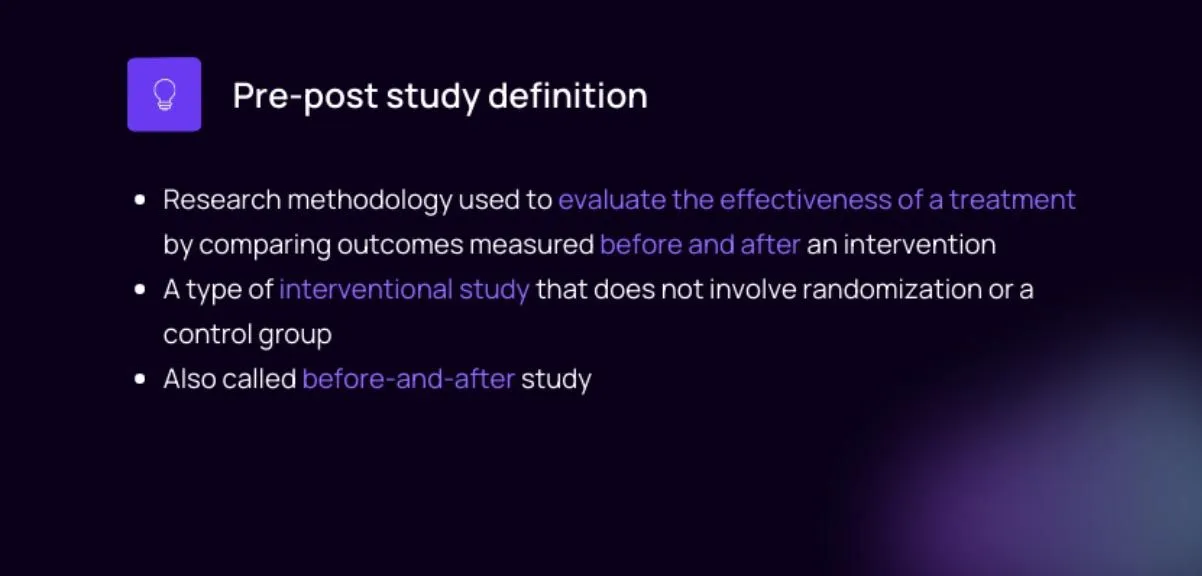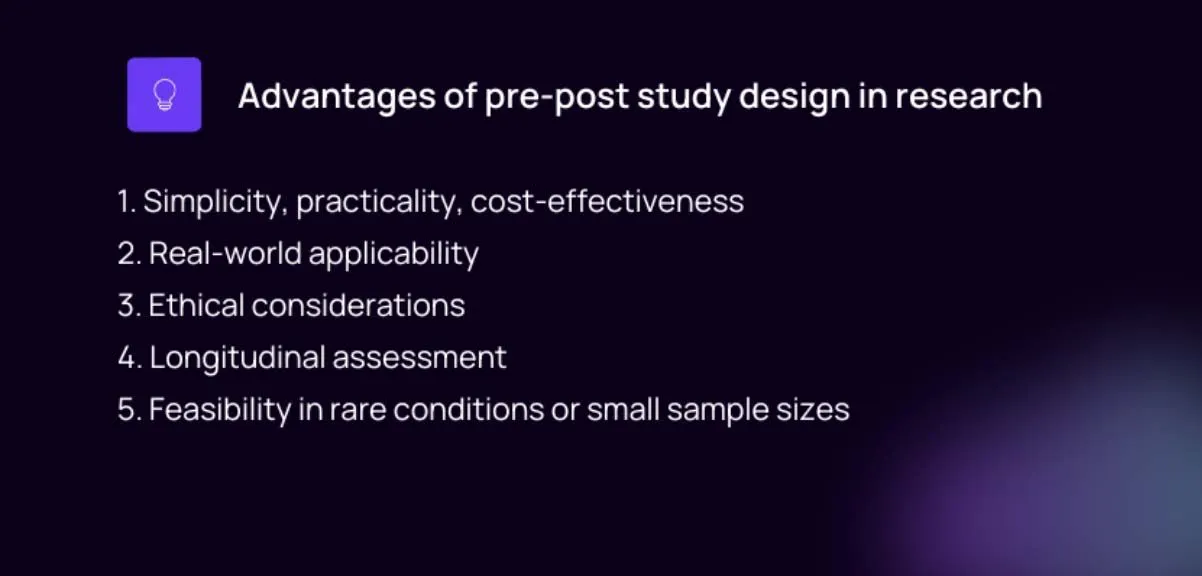Your session is about to expire
Pre-Post Study: Definition, Advantages, and Drawbacks
Pre post study design definition
A pre-post study design is a research methodology used to evaluate the effectiveness of treatments by comparing results measured before and after an intervention. It is commonly used in clinical trials, but can also be applied more broadly in other scientific contexts. Pre-post studies could also be referred to as “before-and-after” studies.

Is a before-and-after study observational?
A pre post study is a type of interventional study rather than an observational study. . A pre-post study could have just a single study arm (i.e., a single-arm pre-post study), or could involve more than one study group.[1] However, such studies are different from randomized controlled trials (RCTs) in that they usually don’t randomize participants or use a control group.[2]
If a study were comparing outcomes before and after a given intervention, but also between the treatment group and a control group, with patients randomized into groups, it would be an RCT, just with a temporal aspect included in the outcome assessments. Pre-post studies are also a type of prospective study design.
Use cases: When would researchers decide to use a pre-post study design?
Clinical research sponsors might opt for a pre-post study design when they want to evaluate the effectiveness of an intervention or treatment by comparing health outcomes before and after its implementation in the same group of participants. This study design is particularly useful in situations where a randomized controlled trial (RCT) is not feasible or ethical, such as when the intervention is already being implemented in a real-world setting or when it would be unethical/irresponsible to deny a necessary treatment to a control group.[2]
There are some specific scenarios wherein a pre-post study design might be a good choice:
1. Impact assessment of a specific intervention or treatment
If a new medication or therapy becomes available, researchers can collect data on the patients' condition before the intervention is implemented and compare that data with the outcomes after the intervention.
2. Program evaluation
Pre-post studies are well-suited to the evaluation of the effectiveness of programs or policies implemented in healthcare settings. Researchers can assess whether the program led to the desired outcomes or improvements in health indicators by comparing real-world data collected before and after the program/policy was implemented.
3. Quality improvement initiatives
For example, if a hospital were to introduce a new protocol to reduce infection rates, researchers could compare infection rates before and after the implementation to determine if the intervention was effective.
4. Longitudinal studies
Pre-post designs can also be used within longitudinal studies to examine changes in outcomes over time in the same individuals or groups. By monitoring outcomes at multiple time points, researchers can observe the evolution of health-related variables and assess the effects of various factors on those variables.
Although pre-post study designs have certain advantages - such as simplicity and practicality - they have limitations compared to RCTs, such as the absence of a control group and potential biases caused by confounding factors. A pre-post study design should be chosen carefully, particularly when randomized or controlled designs would not be ethically feasible, or when available resources are limited and the pre-post study could provide sufficient insight.
What is an example of a pre-post study?
Let’s say that a hospital is interested in studying whether increasing patient access to social workers leads to better health outcomes for patients. In this case, they could utilize a pre-post study design, collecting baseline data on patient health outcomes before providing additional access to social workers (the intervention), and then reevaluating those same outcomes once patients have been given additional access to social workers. By comparing results between the pre- and post-intervention periods (“pre test and post test”), researchers could determine if there were meaningful changes that support the idea that increased social work access was related to improved health outcomes.
Pre post study design level of evidence
The primary advantages of pre-post studies are that they can be comparatively quick to set up and inexpensive to conduct, but the trade-off is that they provide relatively low levels of evidence due to the limited control over confounding variables.[1] The level of evidence provided by a given study design describes the potential degree of validity and reliability of its findings. In general, pre-post studies provide a lower level of evidence than randomized controlled trials (RCTs). RCTs involve randomizing participants into different groups and controlling for external factors that could influence results, which can produce more scientifically robust evidence than pre-post studies. Pre-post analysis can be useful for gaining insight into programs or interventions, but sponsors should use caution when interpreting results due to the potential for bias arising from uncontrolled variables.
What are the benefits of pre and post study design in research?

Pre-post studies are valuable tools for evaluating how interventions affect outcomes over time, and can be applied across many different clinical research settings. They are generally less costly and simpler to implement than RCTs, and can also be feasible with relatively smaller sample sizes. While pre-post study designs might not be able to provide statistically definitive conclusions about causal relationships due to potential confounding variables and a lack of control group, they can provide certain insights and conclusions - which in some cases may suffice, depending on the research question at hand. Further, pre post studies have other unique benefits that make them preferable in certain circumstances.
Some of the main benefits of pre-post study designs are:
1. Simplicity, practicality, cost-effectiveness
Pre-post studies are relatively straightforward to design and implement. They often involve collecting data from the same individuals or groups - just at different time points - which makes them less resource-intensive compared to other study designs.
2. Real-world applicability
Pre-post designs are fit for evaluating interventions or treatments implemented in real-world settings. They provide insights into the effectiveness of these interventions in everyday practice, reflecting the outcomes occurring outside of the controlled research environment typical of RCTs. In this way, they can be considered similar to real-world evidence studies. The real-world practice context can help researchers understand the potential limitations, challenges, and benefits of the intervention when applied in the wider population.
3. Ethical considerations
In some cases, conducting a randomized controlled trial may be ethically unreasonable or simply not feasible, such as when there is an effective standard treatment available for a severe condition and it would be unethical to utilize a control group and withhold the treatment from them. Pre-post designs offer an alternative method for assessing the impact of an intervention without randomizing participants to different study arms.
4. Longitudinal assessments
Pre-post designs allow researchers to examine changes within the same individuals or groups over extended periods of time. By collecting data before and after an intervention, researchers can assess the temporal effects and track the progress of outcomes within a specific population.
5. Feasibility in rare-disease studies or small sample sizes
Pre-post studies can be particularly useful for rare conditions or situations wherein the population size is limited. Since recruiting a sufficient sample for an RCT may be challenging in such cases, a pre-post design allows researchers to gather valuable data and insights with a smaller sample size, further allowing all participants to receive the study treatment.
While pre-post study designs certainly have unique benefits and use-cases, they have significant limitations. Without a control group, it becomes difficult to determine if observed changes are caused by the intervention or influenced by other factors. Researchers should carefully consider the strengths and weaknesses of potential study designs to ensure that it aligns with their research question and provides reliable findings.
Pre post study design limitations
1. Limited level of evidence
A major limitation of the pre-post design is that it cannot prove causality; there may be changes in the outcome variable that are due to factors unrelated to the intervention or study period. Factors such as natural disease progression, concurrent treatments, participant characteristics, or external events can contribute to the observed changes and make it difficult to attribute the outcomes solely to the intervention.[1] With no control group to compare against and less control of confounding variables, the ability to draw scientifically robust comparisons is relatively weaker than that in RCTs.
In addition, “regression to the mean” may be an underlying cause of or contributor to changes observed over time. This refers to the tendency for extreme measurements to move towards the population mean in subsequent measurements. If individuals are selected based on extreme values at baseline, their subsequent measurements are likely to be closer to the mean, which can mistakenly be attributed to the intervention.
Relatedly, outcomes can also change due to natural variance. Over time, factors unrelated to the intervention can naturally change and influence the outcomes. Participants’ conditions can change due to factors such as natural recovery, lifestyle changes, or aging. These external effects can confound the interpretation of the intervention's impact.
2. Bias
Unlike randomized controlled trials (RCTs), pre-post studies do not involve random assignment of participants to different conditions. The lack of randomization introduces the potential for selection bias and limits the ability to control for confounding variables. The results of a pre-post study may not be generalizable (applicable) to other populations or settings due to differences in patient characteristics, healthcare systems, or external factors.[2] However, it could also be argued that if pre-post study is conducted under real-world settings, i.e., using real-world data and real-world evidence, the results could be even more generalizable than those of an RCT due to the better representation of the natural variability in real-world practice and populations.
Finally, in pre-post designs, it is often challenging to blind participants, researchers, or outcome assessors to the intervention status. The absence of blinding can also introduce bias; if participants or researchers have any preconceived notions or expectations regarding the intervention, these could influence their behavior and/or the reported outcomes.
Conclusions
Although they come with certain limitations, a pre-post study can still provide valuable insights into the outcomes of interventions, particularly in real-world settings and when participant randomization or the use of a control group would not be ethically responsible. Clinical researchers can maximize the validity of the findings of pre-post studies through careful consideration of the limitations and potential biases associated with pre-post study designs, and the use of appropriate statistical techniques and sensitivity analyses.